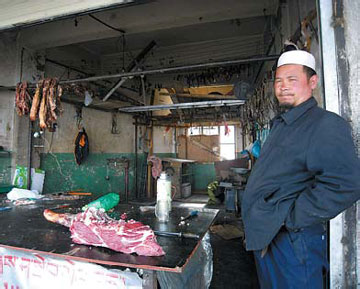Lhasa still scarred but on the mend
By Tan Hongkai (China Daily)
Updated: 2008-04-21 07:30
Updated: 2008-04-21 07:30
"There were eight people trying to pry open the door downstairs - it was horrible," she recalled.
She said she was anxious to sell out everything and leave.
 Ma Alish, an ethnic Hui native from Linxia, Gansu Province, stands in his Lhasa butcher shop. He said the rampage last month cost him more than 700,000 yuan, including a truck. [China Daily] |
More fire-damaged buildings are visible further eastward down Beijing Donglu.
Near the Bank of China branch that was smashed and burnt a newly opened supermarket was cleaned out during the riot.
The same happened to a butcher's shop owned by Ma Alish, an ethnic Hui native of Linxia, Gansu province,
"I never had trouble with anyone, and got along quite well with neighbors, Tibetan or not," said the owner of the outlet between Beijing Donglu and Linkuo Donglu.
"But they just did it, smashing and looting everything, and burning my truck.
"Can you imagine how crazy they were?" he said, pointing out a bunch of broken hooks and locks against the wall on an iron bar.
The rampage cost him more than 700,000 yuan, he claimed.
But he has no plan to leave. "I've been here for 12 years," he said. He has reopened the stall despite performing few repairs.
Though they are not sure exactly how much longer it will take for everything to return to normal, many are confident it won't be long.
Staff of the Sizhongwei, a 15-table eatery run by several Sichuan natives at the west end of Beijing Donglu, expressed their guarded optimism.
"Every day at meal time, there were people waiting for seats," said He Jianyun, the 43-year old owner from Chengdu. "But we closed for five days and a half since noon on March 14 - there was a total mess then."
They are only half a block from the Only store.
Daily turnover has dropped more than a third, cook Liu Bo, who was invited to Lhasa in 1999 by a fellow-townsman, said. But he is confident in both the city's and the restaurant's appeal to tourists.
"We will not have to worry about customers as soon as travelers swarm back," he said. "Though we have no idea when that will be. I only hope we will not miss the summer months." Most tourists visit Tibet between July and October.
The local government promised on Friday that the Tibet autonomous region would "soon" reopen to tourists.
With most of those injured in the riot discharged from hospitals, municipal authorities are trying hard to heal the city's wounds.
A lot of repair work is going on along the devastated Beijing Donglu.
Several stores around the Sichuan restaurant remained open well after 9:30 pm on Saturday as growing numbers of pedestrians passed by.
|
||
|
||
|
|
|
|

